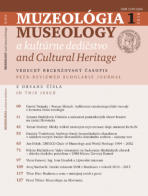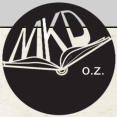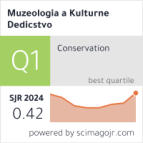

MUZEOLÓGIA
MUSEOLOGY
a kultúrne dedičstvo
and Cultural Heritage

News
Journal Muzeológia a
kultúrne dedičstvo -
Museology and Cultural
Heritage:
SJR 2024: 0,424 (Q1)
Museology SJR rank: 8/83 (Q1) Conservation SJR rank: 11/103 (Q1)JIF WoS 2023: 0,6
JCI WoS 2023: 1,28, Q1 ESCI: 49/411 (Q1)New issue
Muzeológia a kultúrne
dedičstvo 1/2025
online New volume Studia Museologica Slovaca, vol. 8 (2024) online New volume Populačné štúdie Slovenska 17 (2024) onlineNew book
P. Tišliar (ed.). Osobnosti uměleckoprůmyslového muzejnictví (2025). online
Contents 2/2016
Introduction (p.7)
Title: THE INSTITUTE OF ART HISTORY AND THE PROBLEM OF AESTHETIC EDUCATION IN
RUSSIA IN THE FIRST QUARTER OF THE 20TH CENTURY (The institute of art history and the problem
of aesthetic education in Russia in the first quarter of the 20th century)
Abstract: The article is devoted to the activity of the Institute of Art History, related to the development of aesthetic education in
Russia. The author analyzes archival materials related to the Institute’s work in the first quarter of the twentieth century. The
problem of aesthetic education is considered in the overall context of Russian intellectual life of this period.
Author: Ananiev Vitaly Gennadievich
Publication order reference: Saint-Petersburg State University, Department of Museum Studies, Universitetskaja nab. 7-9,
199034 Sankt-Peterburg, Russian, email: v.ananev@spbu.ru
Source: Muzeológia a kultúrne dedičstvo, year: 2016, vol.: 4, number: 2, pages: 9-20.
Key words: INSTITUTE OF ART HISTORY, V.P. ZUBOV, F.I. SHMIT, ART EDUCATION, MUSEUM EDUCATION, MUSEUM
OBJECT AS LEARNING MATERIAL, PET-ROGRAD
Language: ENGLISH
online full-text PDF
Title: KRITIKA KRITICKÉ MUZEOLOGIE (Critical Museology: A Critique)
Abstract: Recently, museological scholarly literature has seen a lot critiques of current muse-um practice and even attempts at a
coherent theory of critical museology or critical heritage studies. While these approaches undoubtedly make a positive contribution
to the debate on the current state of museology, they nevertheless display a number of shortcomings which must be evaluated from
methodological and philosophical standpoints.
Author: Dolák Jan
Publication order reference: Univerzita Komenského v Bratislave, Filozofická fakulta, Ka-tedra etnológie a muzeológie, Gondova
2, 814 99 Bratislava, Slovak Republic, email: jan.dolak@uniba.sk
Source: Muzeológia a kultúrne dedičstvo, year: 2016, vol.: 4, number: 2, pages: 21-33.
Key words: MUSEUM, MUSEOLOGY, MUSEUM STUDIES, CRITICAL MUSEOLOGY, CRITICAL MUSEUM STUDIES
Language: CZECH
online full-text PDF
Title: SPROSTREDKOVANIE VÝTVARNÉHO UMENIA NÁVŠTEVNÍKOM GALÉRIÍ A MÚZEÍ UMENIA
ZA POMOCI VYUŽITIA ANIMÁCIE A ARTETERAPIE (Mediating visual art to gallery and museum visitors
using animation and art therapy)
Abstract: Mediation of visual art using animations and art therapy is one of the processes commonly used in art galleries and
museums in Western Europe to increase the public’s en-gagement with art. This paper discusses these methods and the potential
for their application in Slovak galleries with the goal of making these methods more widely known and encourage their adoption in
museum and gallery practice. In the first part, we examine the nature of art, its importance and its role in museum and gallery
education. The second part of the paper then analyzes the concept of gallery animation, its objectives, methods, typology and
various ways of its implementation using specific examples. In the final section, the paper turns to the issue of mediation of visual
art in art therapy and various ways of implementing the methodology in the conditions of Slovak art galleries and museums.
Author: Györgyfiová Michaela
Publication order reference: Súkromná základná škola, Ružová dolina 29, 821 09 Bratislava, Slovak Republic, email:
michaela.gyorgyfiova@gmail.com
Source: Muzeológia a kultúrne dedičstvo, year: 2016, vol.: 4, number: 2, pages: 35-46.
Key words: FINE ART, ANIMATION, ART THERAPY, PROCUREMENT
Language: SLOVAK
online full-text PDF
Title: MÚZEÁ BEZ BARIÉR : SPRÍSTUPŇOVANIE VÝSTAV A EXPOZÍCIÍ PRE NÁVŠTEVNÍKOV SO
ŠPECIÁLNYMI POTREBAMI (Museums without obstacles: Making exhibitions and expositions accessible
to special needs visitors)
Abstract: It is not only a legal obligation, but also a moral and ethical imperative, that every cultural institution make itself and its
activities accessible to the public which includes people with various special needs. A careful analysis of these needs and the way
to address them in a person‘s day-to-day life can be an inspiration for the creation of more accessible exhibtions and expositions.
This paper analyzes several types of such accessibility-improving measures by type, e.g. a guiding line through the exhibition,
labels in Braille, haptic models and audio-guides for those with visual impairments, videomonitors and sign-language guides for
those with auditory impairments, improved physical access for those with reduced mobility and alike. Additionally, I highlight various
small changes to the overall active and passive com-munication with the visitors that can be improved to access the exhibition‘s
accessibility - after all, a well-prepared museum guide can often do much more to increase the visitors‘ en-gagement with the
museum than any special tools. The final section of the paper contains a report on a survey of current exhibitions and expositions
which are aimed at special needs visitors.
Author: Jamrichová Lívia
Publication order reference: Univerzita Komenského v Bratislave, Filozofická fakulta, Ka-tedra etnológie a muzeológie, Gondova
2, 814 99 Bratislava, Slovak Republic, email: li-via.jamrichova@gmail.com
Source: Muzeológia a kultúrne dedičstvo, year: 2016, vol.: 4, number: 2, pages: 47-66.
Key words: MUSEUM, EXHIBITION, EXPOSITION, SPECIAL NEEDS VISITORS, ACCESSIBILITY
Language: SLOVAK
online full-text PDF
Title: TECHNIKA V MUZEJNÍ KULTUŘE (Technology and the museum culture)
Abstract: For the purposes of this paper, I define technology as the society‘s constantly deve-loping activity focusing on
manufacturing processes and related conditions. As such, techno-logy has always closely followed the society‘s development in
general and the broadening of its scientific horizons in particular and it has always been inexorably tied to philosophy. The
documentation of technology in a museum environment must be viewed as a part of the scien-tific effort which must be very well
documented. Museums of technology emerged gradually as the society‘s interest in technology in general deepened in the Age of
Discovery and the subsequent Industrial Evolution. In the historic lands of the Czech crown, the emergence of museums in general
and technology museums is tied to the nationalist revival and the related expansion of education to a wider share of the population
which is reflected in their nature and scope. The period of 1989 then sees a wider proliferation of technology museums to such
extent that while a basic typology of such museums can be established, there are institutions of this type which are very difficult to
classify and label.
Author: Nekuža Petr
Publication order reference: Technické muzeum v Brne, Purkyňova 105, 612 00 Brno - Královo Pole, Czech Republic, email:
nekuza@technicalmuseum.cz
Source: Muzeológia a kultúrne dedičstvo, year: 2016, vol.: 4, number: 2, pages: 67-74.
Key words: TECHNOLOGY, MANUFACTURING PROCESSES, SCIENTIFIC KNOW-LEDGE, INDUSTRIAL REVOLUTION,
PHILOSOPHICAL SCHOOLS, CULTURAL DEVELOPMENT, DOCUMENTATION, COLLECTION OF ART OBJECTS, CURIOSITY
CABINET, MEMORY INSTITUTION
Language: CZECH
online full-text PDF
Title: INŠTITUCIONALIZÁCIA PAMÄŤOVÝCH A FONDOVÝCH ZARIADENÍ V 50. A 60. ROKOCH 20.
STOROČIA V OKRESE ROŽŇAVA : PRÍSPEVOK K VÝSKUMU REGIONÁLNEJ KULTÚRNEJ
POLITIKY A KULTÚRNEJ STRATÉGIE 2. POL. 20. STOROČIA NA SLOVENSKU (Institutionalization of
memory and archival institutions in the 1950s and 1960s in the Rožňava county : A contribution towards
the study of regional policy and cultural strategy in mid-20th century Slovakia)
Abstract: This paper examines the institutionalization of memory institutions in the 1950s and the 1950s in the Rožňava region as
an example of the preparation and implementation of go-vernment regional cultural policy in Slovakia. During this period, the
government succeeded for the first time to lay the fundaments of memory institutions such as libraries, archives and museums.
This, however, was achieved with distinct political and ideological goals in mind which was reflected not only in cultural and
educational activities of these institutions, but also in their collections. Additionally, the neglect that cultural issues had suffered in
the pre-vious decades resulted in the lack of qualified staff and location-related issues.
Author: Tišliar Pavol
Publication order reference: Univerzita Komenského v Bratislave, Filozofická fakulta, Ka-tedra etnológie a muzeológie, Gondova
2, 814 99 Bratislava, Slovak Republic, email: pa-vol.tisliar@uniba.sk
Source: Muzeológia a kultúrne dedičstvo, year: 2016, vol.: 4, number: 2, pages: 75-85.
Key words: LIBRARIES, MUSEUMS, ARCHIVES, REGIONAL CULTURAL POLICY, ROŽŇAVA REGION, 1950-1960
Language: SLOVAK
online full-text PDF
Title: HISTÓRIA A SÚČASNOSŤ NOVOHRADSKÉHO MÚZEA A GALÉRIE V LUČENCI (The Novohrad
Musem and Gallery in Lučenec past and present)
Abstract: The Novohrad Museum and Gallery in Lučenec specializes in the regional history of enamel- and glass-making and
visual arts. It holds a collection of over 30,000 art, archeo-logical, historical and ethnological objects. Since 1983, the musem and
gallery have been a host to the annual Acquarelle Triennale and since 1989, it has hosted the oldest symposium of its kind in
Slovakia, the International Ceramic Symposium, which showcases the contempora-ry ceramic production in Slovakia. This paper
outlines the history of the museum and its focus, concentrating on the work done in the last decade.
Author: Škodová Michaela
Publication order reference: Novohradské múzeum a galéria, Kubínyiho nám. 3, 984 01 Lučenec, Slovak Republic, email:
skodova@nmg.sk
Source: Muzeológia a kultúrne dedičstvo, year: 2016, vol.: 4, number: 2, pages: 87-93.
Key words: THE NOVOHRAD MUSEUM AND GALLERY, LUČENEC, NOVOHRAD, MUSEOLOGY
Language: SLOVAK
online full-text PDF
Title: SALAŠNÝ CHOV OVIEC V DETVE A NA SLOVENSKU (Salaš-type sheep farms in Detva and in
Slovakia)
Abstract: This paper analyzes the history of sheep raising in Slovakia and especially in the city of Detva and the surrounding
region (Podpoľanie). The so-called Wallachian colonization in the 14th century introduced a new type of sheep raising centered
around the salaš, an isolated farm unit, practiced predominantly in mountainous regions and focused on milk production. This
change had a profound effect not only on the population‘s food production, but also on a number of aspects of the traditional culture
(dress, household production, folklore, customs etc.) in most of the territory of present-day Slovakia. Indeed the elements of the
imported salaš culture, adapted to local conditions and developed in idiosyncratic ways, have become some of the major ethnic
identifiers of the Slovak people. In Detva, sheep raising has always been closely tied to the traditional way of life. The - for this
region typical - predominance of isolated farms came about as an extension of the Wallachian salaš culture. The focus on sheep
raising motivated by the availability of grazing land created a unique individual form of sheep raising specific for the region of
Podpoľanie.
Author: Janto Juraj
Publication order reference: Univerzita Komenského v Bratislave, Filozofická fakulta, Ka-tedra etnológie a muzeológie, Gondova
2, 814 99 Bratislava, Slovak Republic, email: ju-raj.janto@uniba.sk
Source: Muzeológia a kultúrne dedičstvo, year: 2016, vol.: 4, number: 2, pages: 95-106.
Key words: CARPATHIAN SHEEP RAISING, WALLACHIAN COLONIZATION, SALAŠ CULTURE, DETVA, PODPOĽANIE
Language: SLOVAK
online full-text PDF
Title: FARBENÉ DO MODRA – PRÍBEH MODROTLAČE (In shades of blue: The story of blue print)
Abstract: The Museum of Folk Art Production in Stupava was founded in 2008 as an organi-zational unit and a dedicated worksite
of the Center of Folk Art Production (ÚĽUV). In 2014 - in accordance with its mission statement to explore, document, preserve and
make available to the public all artifacts related to Slovak art - the Museum focused its activities on blue print items from its own
collections. This collection continues and builds on the work begun by the Center of Folk Art Production in 1948 with the
establishment of the Kroj cooperative which aimed to study and concentrate blue print item production in Slovakia.
Author: Jaďuďová Libuša
Publication order reference: ÚĽUV – Múzeum ľudovej umeleckej výroby, Dlhá 8/C, 900 31 Stupava, Slovak Republic, email:
jadudova@uluv.sk
Source: Muzeológia a kultúrne dedičstvo, year: 2016, vol.: 4, number: 2, pages: 107-116.
Key words: ÚĽUV, FOLK ART, BLUE PRINT, MUSEUM, CULTURAL HERITAGE
Language: SLOVAK
online full-text PDF
Title: LIBRI PROHIBITI: ZÁSAHY POLITIKY DO KNIŽNEJ PRODUKCIE A KNIŽNIČNÝCH FONDOV
POČAS DRUHEJ SVETOVEJ VOJNY NA PRÍKLADE MESTA NITRA (Libri prohibit: Government
interference with book production and book collections during World War II as exemplified by the city of
Nitra)
Abstract: In post-1939 Slovakia, the government adopted several measures to exercise undue control over its citizens and
influence their views and opinions. During World War II, a num-ber of censorship decrees were issues which sought to control what
information was made public in the press, on the radio and in movies and other artistic productions. This paper exa-mines book
censorship during that period, analyzing the role of specific institutions which were tasked with excising the undesirable literary
production, describing the process of „clea-ning up“ libraries and looking at what works and which authors were considered
unacceptable by the ruling regime, focusing on the city of Nitra.
Authors: Palárik Miroslav, Mikulášová Alena
Publication order reference: Univerzita Konštantína Filozofa v Nitre, Filozofická fakulta, Katedra histórie, Hodžova 1, 949 01
Nitra, Slovak Republic, email: amikulasova@ukf.sk; mpalarik@ukf.sk
Source: Muzeológia a kultúrne dedičstvo, year: 2016, vol.: 4, number: 2, pages: 117-137.
Key words: LIBRARIES; BOOK CENSORSHIP; SLOVAK REPUBLIC 1939 – 1945; NITRA; CENSORSHIP
Language: SLOVAK
online full-text PDF
Title: VÝROČNÉ SPRÁVY ŠKÔL AKO ARTEFAKTY KNIŽNEJ KULTÚRY A PRAMENE K DEJINÁM
ŽIDOVSKÉHO ŠKOLSTVA NA SLOVENSKU (The annual school reports as artefacts of book culture and
sources on the history of Jewish education in Slovakia)
Abstract: This paper outlines the history of the annual school reports publishing on the terri-tory of Slovakia. It also provides the
basic bibliographic sources in which the annual school reports are registered. The annual school reports began to be systematically
published in the second half of the 19th century. Also the Jewish schools, which history is much older (e. g. a school existed at the
synagogue in Bratislava as early as 1416) published them. During the extensive research in libraries in Slovakias well as 21 titles
of the annual school reports of some Jewish schools published in Slovakia until 1918 were found. The annual school reports of the
primary schools, business schools, religious schools (the so-called talmud-tóra), boys‘ schools, girls‘ schools and co-educational
schools are among them. The content of the annual school reports of Jewish schools is presented in the example of the annual
school report of the boys‘ public school associated with the business school in Bratislava and public school in Liptovsky Mikulas. As
artefacts of book culture they are an especially a rich source of infor-mation about a particular school, they document publishing
activities of a school or its foun-ders and complete the knowledge about production of individual printers and printing houses.
Through the ownership stamps and records they provide information about previous owners and assist in the reconstruction of the
library stocks. At the moment known annual school reports of Jewish schools are certainly only a part of a larger, not yet fully
discovered corpus (e. g. we can assume the existence of the annual school reports of the higher schools - yeshivas in Hebrew).
Their systematic research, documentation and expert processing should become part of research and protection of Jewish cultural
heritage in Slovakia.
Author: Fircáková Kamila
Publication order reference: Knižnica SNM-Múzea židovskej kultúry v Bratislave, Židovská 17, 811 01 Bratislava, Slovak
Republic, email: fircakova@snm.sk
Source: Muzeológia a kultúrne dedičstvo, year: 2016, vol.: 4, number: 2, pages: 139-148.
Key words: BOOK CULTURE, ANNUAL SCHOOL REPORTS, JEWISH SCHOOLS, SLOVAKIA
Language: SLOVAK
online full-text PDF
I n P r a c t i c e
Oto Makýš: Financial support provided for the purposes of historic building renovation
by the Slovak Ministry of Culture (p. 149)
Daniela Tvrdoňová: Popularizing activities of the Slovak National Archives
within the last decade (p. 157)
Books received a reviews
Jan Dolák: The history of Slovakia: A new exhibition at the Bratislava castle (p. 165)
Michal Uhrin: „The Slovak-Slovenian Dimension“: An exhibition (p. 168)
Jan Dolák: A new exhibition in Liptovský Mikuláš (p. 171)
Dana Lacová: „This is how Petržalka used to be.“ Petržalka between 1973 and 1989 (p. 173)
News
Zuzana Lintnerová: The 2016 Poland field trip (p. 176)
Pavol Tišliar: A brief report on the activities of the study specialization
„Museology and cultural heritage“ in the academic year 2015/2016 (p. 179)
Articles (Abstracts)

ISSN 1339-2204
Vol. 4 (2016), No. Is. 2
Full-text version pdf


























